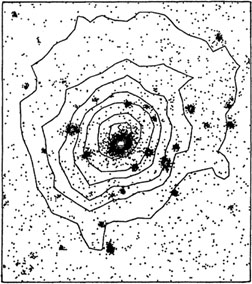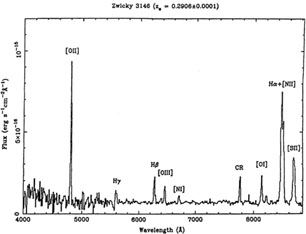Copyright © 1994 by Annual Reviews. All rights reserved
| Annu. Rev. Astron. Astrophys. 1994. 32:
277-318 Copyright © 1994 by Annual Reviews. All rights reserved |
The X-ray image of the cluster around the radio galaxy 3C295 at
redshift z = 0.46 has the peaked shape of a cooling flow
(Henry & Henriksen
1986)
and many of the distant clusters found serendipitously
by the Einstein Observatory and by ROSAT have a massive
central galaxy with optical line emission
(Donahue et al 1992,
Allen et al 1992a,
Crawford et al 1994)
which often accompanies a cooling flow (all
nearby central galaxies with line emission are in cooling flows but
not all central galaxies in flows have optical line emission). The
peaked X-ray emission also makes the clusters more detectable
(Pesce et al 1990).
A similar correlation of optical activity is found in
spectra of part of the ROSAT Brightest Cluster Sample (BCS;
Allen et al 1992a,
Crawford et al 1994).
The fraction of clusters with detected
line emission does not appear to increase with z. The central galaxy
with the highest H luminosity, Z3146, at a redshift of 0.3 is in the
BCS. A ROSAT HRI image of this cluster
(Figure 8) indicates a massive
cooling flow of about 1000
M
luminosity, Z3146, at a redshift of 0.3 is in the
BCS. A ROSAT HRI image of this cluster
(Figure 8) indicates a massive
cooling flow of about 1000
M yr-1
(Edge et al 1994).
yr-1
(Edge et al 1994).

|

|
Figure 8. ROSAT HRI contours
overlaid on an optical image (left panel)
and the optical spectrum of the central galaxy in Z3146, from
Edge et al (1994) and
Allen et al (1992a),
respectively. The cooling flow in
the cluster, at z = 0.29, is about 1000
M |
X-ray data (Edge et al 1990, Gioia et al 1990) and theoretical models (e.g. Evrard 1990, Katz & White 1993) show that clusters have evolved in a hierarchical manner and are continuing to do so such that the most luminous clusters are most numerous now. This has a profound effect on the evolution of cooling flows. The usual merger of a smaller cluster with a larger one introduces cooler gas from the smaller cluster and causes much stirring and turbulence in the gas in the core of the large one. Any cooling flow is strengthened (or initiated) and the turbulence dissipates by stirring mixing layers onto, and shocks between, cold clouds, thus enhancing the luminosity of the central optical nebulosity. The central galaxies also merge rapidly. The unusual merger of two large sub-clusters in which the central galaxies do not combine leads to the disruption of cooling flows, although cooling may continue in an unfocused manner (Fabian et al 1984b).
What is not immediately clear from this picture is whether cooling flows were stronger in the past or weaker, White (1988) has argued from the data that flows are increasing in strength with time, although this may in part be in a recovery sense since the last merger. Techniques developed by Bertschinger (1989) and Chevalier (1987) will be useful in estimating the theoretical evolution of flows. Henriksen (1993) has noted that cD clusters with a close and similar companion cluster do not have cooling flows and suggests that these pre-merger clusters are closer to the initial state and thus that the flows were generally weak in the past. McGlynn & Fabian (1984), on the contrary, argued from a similar consideration of the A399 / 401 pair that they may have already interacted and passed through each other before an eventual merger, so destroying any central flows. Much more observational and theoretical work on the behavior of the ICM, and of central cluster galaxies, during mergers is needed before any definitive statement can be made. Hierarchical cluster formation predicts that flows were much stronger in the past and more numerous, since there were then more subclusters.
Although the optical activity and the radio emission of the central galaxy generally involve only a small fraction of the cooling flow (in both radius and power sense), they can be used to identify and infer the properties of very distant cooling flows. Cygnus A, for example, has a well-detected cooling flow (Arnaud et al 1984) and indeed the high-pressure surrounding gas is probably necessary to cause such luminous radio emission (the gas is the working surface for the radio jet).
Most distant radio-loud quasars and galaxies have strong extended optical (and UV) line emission. The emission is so strong that it must be photoionized by the active nucleus of ionizing luminosity Lion. The ionization state of the optical emitting gas can then be used to determine the pressure of the surroundings, e.g.
where the gas pressure P = nT exceeds 104
cm-3 K in a cooling flow and
is 106-107 cm-3 K at 10 kpc. The
function f can be computed using a
code such as Ferland's CLOUDY. Observations of radio-loud quasars,
where optical/X-ray data constrain Lion show that
P decreases with
radius around individual quasars and increases with redshift in a
sample of quasars
(Crawford et al 1988;
Crawford & Fabian 1989;
Forbes et at 1990;
Heckman et al 1991a,
b;
Bremer et al 1992).
The
correlation could be more with L than with redshift, but it is clear
that the environment of luminous radio-loud quasars has a higher
pressure at z
There may be some feedback between a cooling flow and a quasar,
since the quasar radiation has a Compton temperature of about 106
K. This locks the temperature of the gas in the innermost few 100 pc
and increases fuel to the quasar since all gas phases flow together
into the center. The accretion rate then rises to the Eddington
limit. A cluster-cluster merger can however disrupt the feedback and
so switch off the quasar
(Fabian & Crawford
1990).
The net effect is
that the most luminous quasars are in the richest clusters that have
not suffered a (roughly) equal collision.
There is considerable other evidence for a dense hot intracluster
medium around powerful distant radio-loud objects. Direct galaxy counts
(Yee & Green 1987,
Yates et al 1989,
Hill & Lilly 1991)
show that these radio-loud objects are in clusters that appear richer at
higher redshift and that their host galaxies are very luminous and
hence massive
(Romanishin &
Hintzen 1989).
Radio data show strong Faraday depolarization
(Garrington et al
1988,
Laing 1988),
similar to that seen in Cygnus A
(Dreher et al 1987)
and other nearby cooling flows (e.g.
Ge & Owen 1993),
which requires a dense screen of
electrons. This result has recently been extended to above a redshift
of 3 by
Carilli et al (1994)
who have found that the most distant
radio galaxies are surrounded by similar Faraday screens. The
equipartition pressures obtained from the low surface brightness radio
emission away from the heads of the radio lobes at z
In summary, there is strong evidence that powerful radio-loud
objects are surrounded by dense, cooling, intracluster (or intragroup)
gas. Whether there are massive cooling flows at redshifts above 0.5
not associated with active objects is not known. Optically rich
clusters at redshifts approaching 1 do not have X-ray luminosities
much exceeding 2 x 1044 erg s-1
(Castander et al 1994),
which limits any cooling flows to << 1000
M
It is possible that X-ray absorption by the large quantities of
cooled gas from a maximal flow smothers the X-ray emission from the
flow. Only when powerful radiojets from the center clear a path from
the nucleus is the emission from the inner regions easily
detectable. In that case though, the luminosity of the (quasar)
nucleus may outshine that from the cooling gas. Dusty cooling flows
may occur in the infrared-luminous, optically polarized, radio
galaxies IRAS 10214+4724
(Lawrence et al 1993)
and IRAS 0914+4109
(Hines & Wills 1993).

 0.5. For confining gas at a particular temperature,
tcool
0.5. For confining gas at a particular temperature,
tcool  P-1 so higher pressures mean that gas in any reasonable
potential well has a higher cooling rate. Indeed some of the objects
must be at the limit where tcool ~
tgrav, which we dub "maximal" cooling
flows - the gas is cooling as fast as it is falling and cannot be any
denser. (It is not a coincidence that the most radio luminous objects
occur in such an environment.)
P-1 so higher pressures mean that gas in any reasonable
potential well has a higher cooling rate. Indeed some of the objects
must be at the limit where tcool ~
tgrav, which we dub "maximal" cooling
flows - the gas is cooling as fast as it is falling and cannot be any
denser. (It is not a coincidence that the most radio luminous objects
occur in such an environment.)
 0.5 is
high. Also the radio sources are smaller for the same power
(Barthel & Miley 1988).
The optical-radio alignment effect, in which a blue
optical continuum extends for tens of kpc along the radio axis and is
also polarized
(Tadhunter et al 1992
and references therein), is
consistent with electron scattering in a dense intracluster medium
(Fabian 1989)
or widely distributed dust (such as could form in
distributed cold clouds). The ROSAT PSPC detection of the
z = 1.079 radio galaxy 3C356
(Crawford & Fabian
1993a)
is consistent with a hot,
dense gaseous halo, and Einstein Observatory HRI observations of the
double quasar 0957+561 indicate that it has a neighboring, 8 kpc
offset extended X-ray emission region magnified by the gravitational lens
(Jones et al 1993).
If due to hot gas, such a detectably-bright
region must have a short cooling time and could be the peak of a
surrounding flow. Its off-nucleus nature resembles that of the peak of
emission in the Perseus cluster around NGC 1275
(Figure 3).
0.5 is
high. Also the radio sources are smaller for the same power
(Barthel & Miley 1988).
The optical-radio alignment effect, in which a blue
optical continuum extends for tens of kpc along the radio axis and is
also polarized
(Tadhunter et al 1992
and references therein), is
consistent with electron scattering in a dense intracluster medium
(Fabian 1989)
or widely distributed dust (such as could form in
distributed cold clouds). The ROSAT PSPC detection of the
z = 1.079 radio galaxy 3C356
(Crawford & Fabian
1993a)
is consistent with a hot,
dense gaseous halo, and Einstein Observatory HRI observations of the
double quasar 0957+561 indicate that it has a neighboring, 8 kpc
offset extended X-ray emission region magnified by the gravitational lens
(Jones et al 1993).
If due to hot gas, such a detectably-bright
region must have a short cooling time and could be the peak of a
surrounding flow. Its off-nucleus nature resembles that of the peak of
emission in the Perseus cluster around NGC 1275
(Figure 3).
 yr-1 unless there is much absorption and/or
the virial temperature is lower than 2 key.
yr-1 unless there is much absorption and/or
the virial temperature is lower than 2 key.